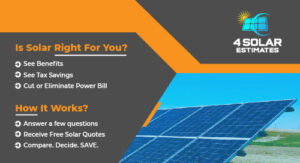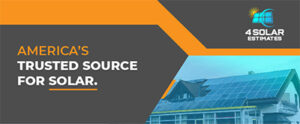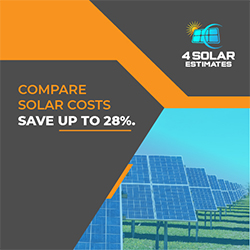
Are Solar Panels Better Than Electricity?
In the modern world, where sustainability and green living are not just trends but necessities, the question often arises: “Are solar panels better than traditional electricity?” While there’s no one-size-fits-all answer, this blog will explore the many advantages and some disadvantages of solar energy, all while encouraging you to see why investing in solar panels can be a wise choice for your future and the environment.
COMPARE SOLAR QUOTESThe Benefits of Solar Energy
1. Environmentally Friendly
Unlike traditional electricity, which often relies on fossil fuels, solar panels generate energy from the sun, a renewable resource. This process does not emit greenhouse gases, making it a clean and environmentally responsible choice.
2. Cost-Effective in the Long Run
While the initial cost of solar panels can be substantial, the long-term savings are impressive. Once installed, the energy is virtually free, and maintenance costs are typically low. Many governments even offer incentives, tax credits, and rebates for solar installation, further lowering the financial barriers.
3. Energy Independence
With solar panels, you’re generating your own electricity. This means reduced dependence on utility companies and immunity from price fluctuations in the energy market. You have more control over your energy costs, and in some cases, you can even sell excess energy back to the grid.
4. Increase in Property Value
Solar panels are a valuable addition to any property. Studies have shown that homes with solar energy systems sell faster and at higher prices compared to those without.
5. Works in Most Locations
Solar energy isn’t just for sunny locales. Even in areas with less direct sunlight, solar panels can still generate energy, albeit less efficiently. Technological advancements are continually improving the efficiency of solar panels in various weather conditions.

The Drawbacks of Solar Energy
While the benefits of solar energy are considerable, it’s important to understand the potential drawbacks.
1. Initial Costs
The upfront costs of purchasing and installing solar panels can be high. However, considering the long-term savings and available incentives, this investment often pays for itself over time.
2. Weather Dependent
Solar energy production can be affected by weather conditions such as cloud cover and rain. However, as mentioned earlier, advancements in technology are mitigating this issue, and energy storage solutions are becoming more prevalent.
3. Space Requirements
Installing solar panels requires ample space, usually on rooftops. This might not be suitable for every property, though creative solutions like community solar gardens are expanding accessibility.
COMPARE SOLAR QUOTESA Bright Future with Solar Panels
Are solar panels better than traditional electricity? The answer may vary depending on individual needs and preferences, but the overarching trend leans heavily towards “Yes.”
Solar energy offers an eco-friendly, cost-effective, and energy-independent solution that’s likely to be even more advantageous as technology advances. While there are some considerations to keep in mind, such as initial costs and space requirements, the incentives and long-term benefits make solar panels a compelling investment.
By embracing solar energy, you’re not just choosing a more sustainable lifestyle; you’re investing in the future of our planet. The sun’s rays are a gift that keeps on giving, and with solar panels, you can harness that gift to power your life in a way that aligns with both your financial goals and ethical values. Whether you’re a homeowner looking to reduce bills or a business seeking to make a positive impact, solar panels stand out as a bright and promising choice.

How Much Do Solar Panels Cost vs Traditional Electricity?
When considering the switch to solar energy, one of the most significant questions you might have is the cost comparison between solar panels and traditional electricity. Let’s dive into an exploration of the financial aspects of both options, looking at both initial expenses and long-term savings.
Initial Costs of Solar Panels
The upfront costs of solar panels include purchasing the panels, inverters, wiring, and professional installation. Depending on the size and complexity of the system, these costs can range from $15,000 to $25,000 for an average-sized home. It’s essential to note that many federal and state incentives can significantly reduce these initial costs.
Ongoing Costs of Solar Panels
Once installed, solar panels require minimal maintenance. Occasional cleaning and routine checks by a professional are the main ongoing expenses, which typically don’t exceed a few hundred dollars per year. Plus, many manufacturers offer long-term warranties, sometimes as long as 25 years, providing added financial security.
Costs of Traditional Electricity
For a traditional electricity consumer, there are no initial installation costs, but monthly energy bills can add up quickly. The average American household spends about $1,200 annually on electricity. Over time, these costs tend to rise due to inflation and fluctuations in energy prices.
Long-term Comparison
While the initial costs of solar panels are higher, the long-term savings make it a wise investment for many:
- Solar Panels: After the break-even point, which can be anywhere from 5 to 10 years depending on the system and incentives, the electricity generated is virtually free. If the system is connected to the grid, you may even earn money back for excess energy production.
- Traditional Electricity: The ongoing costs continue indefinitely, and there’s no opportunity for generating income through energy production. The total expenditure over 20 years can easily exceed $30,000, without considering potential increases in energy prices.
A Matter of Perspective
Comparing solar panels’ cost to traditional electricity requires a comprehensive view. The initial investment in solar energy is undoubtedly higher, but the long-term financial benefits often outweigh these upfront costs.
By opting for solar panels, you’re not only choosing a more sustainable energy source but potentially saving thousands of dollars in the long run. The cost efficiency, paired with environmental considerations, makes solar panels a viable and often preferable option for many homeowners and businesses seeking to reduce both their energy bills and carbon footprint.

Solar Tax Incentives and Eligibility
Solar tax incentives have played a vital role in making solar energy more accessible and affordable. By reducing the financial burden of installation, these incentives promote the adoption of renewable energy, aligning with global efforts to combat climate change. Here are some of the significant solar tax incentives that you may be eligible for:
Federal Investment Tax Credit (ITC)
The Federal Investment Tax Credit, also known as the Solar ITC, allows homeowners and businesses to deduct a portion of the cost of installing a solar energy system from their federal taxes. As of 2023, the tax credit is 22% of the cost of the system. It’s scheduled to phase out for residential systems after 2023, while commercial systems will continue to receive a 10% credit.
State Solar Incentives
Many states offer additional incentives to further lower the costs of going solar. These can include:
- State Tax Credits: Similar to the federal ITC, some states offer their own tax credits, ranging from 10% to 30% of the system’s cost.
- Solar Rebates: Rebates are cashback offers provided by state governments, utilities, or manufacturers. The amount can vary widely by location and provider.
- Property Tax Exemptions: Several states exempt the added value of a solar system from property taxes, helping homeowners save on annual tax bills.
- Sales Tax Exemptions: Some states waive the sales tax on solar panel purchases, reducing the overall cost of the system.
Net Metering
Net metering is a billing mechanism that credits solar energy system owners for the electricity they add to the grid. If your system produces more energy than you consume, you can sell this excess energy back to the utility company at a retail rate. This can lead to further savings or even revenue, depending on the size of your system and energy consumption.
COMPARE SOLAR QUOTESLocal Incentives and Programs
Local governments and utility companies may offer additional incentives and financing options. These can include low-interest loans, grants, or specific rebates for particular products or practices.
Exploring Your Options
Taking advantage of solar tax incentives requires careful planning and awareness of the opportunities available in your area. Consulting with a solar professional and possibly a tax expert can help you navigate the incentives that apply to your specific situation. By leveraging these incentives, you can significantly reduce the costs of solar panel installation, making the switch to renewable energy even more attractive. Whether you’re an individual homeowner or a business owner, these incentives can make solar energy an economically sound and environmentally responsible choice.

Are Solar Panels Safe? Ensuring Safety for Your Family
Solar panels have become increasingly popular for their efficiency and environmental benefits. But a question that often arises is, “Are solar panels safe?” Let’s explore the safety aspects of solar panels, including the inspection process, to assure you that they are indeed a secure option for your family.
Safety Standards and Regulations
Solar panels must comply with rigorous safety standards and regulations. These guidelines ensure that the panels are manufactured, installed, and operated under stringent safety conditions. Compliance with international standards like the IEC (International Electrotechnical Commission) guarantees that the panels are tested for quality, durability, and safety.
Installation Safety
Proper installation is crucial for the safety of solar panels. A certified and experienced installer will assess the structural integrity of your roof, determine the optimal placement, and secure the panels with the right mounting system. By adhering to best practices, the risk of panels coming loose or causing damage is minimized.
Electrical Safety
Solar panels produce electricity, so proper electrical connections and protections are vital. Quality inverters, connectors, and wiring must be used, and all connections must be properly grounded to prevent electrical shocks or fires. A professional installer will follow the National Electrical Code (NEC) standards to ensure electrical safety.
COMPARE SOLAR QUOTESInspection Process
The inspection process plays an essential role in confirming the safety of the solar panel system:
- Pre-Installation Inspection: Before installation, the site is assessed to identify any potential risks or challenges. This ensures that the system will be installed safely and effectively.
- Post-Installation Inspection: After installation, a thorough inspection is performed by a certified inspector to verify that the system complies with all relevant codes and standards. This includes structural, electrical, and fire safety inspections.
- Ongoing Maintenance and Inspections: Regular maintenance and inspections are recommended to ensure that the system continues to operate safely. This includes checking for any wear and tear, loose connections, or other potential issues.
Safety for Your Family
Solar panels are designed with several safety features that make them suitable and secure for residential use:
- No Moving Parts: Solar panels have no moving parts, reducing the risk of mechanical failures or injuries.
- Fire Safety: Quality solar panels are designed with fire safety in mind, including the use of fire-resistant materials and proper grounding.
- No Emissions: Solar panels generate electricity without emitting harmful substances, contributing to a healthier living environment.
Embracing Solar with Confidence
Solar panels are not only efficient and eco-friendly but also safe for your family. By choosing a reputable provider, ensuring proper installation, and adhering to regular maintenance and inspections, you can confidently embrace solar energy. The safety standards, combined with the professional handling of the system, provide peace of mind that the solar panels on your roof are a secure and prudent investment for your home and the environment.

How Much Do Solar Panels Actually Cost? An Investment Worth Every Penny
Solar panels are an exciting investment that can reduce your energy bills and make your home more sustainable. But what about the cost? Let’s delve into the actual average costs of solar panels, including the per square foot price and labor costs. Plus, we’ll explore financing options that could make this green choice even more affordable.
Cost of Solar Panels Per Square Foot
The cost of solar panels varies widely depending on the type, efficiency, and brand. On average, the price ranges from $2.50 to $3.50 per watt, which translates to approximately $15 to $21 per square foot. High-efficiency or premium brands might cost more, but they also tend to generate more electricity.
Installation and Labor Costs
The labor costs to have solar panels installed by a professional can add to the overall expense but are a vital part of ensuring the system’s safety and efficiency. Installation costs typically range from $0.50 to $1.00 per watt, or $3 to $6 per square foot. This includes site assessment, system design, installation, electrical work, and final inspections.
Additional Costs
It’s essential to consider other costs that may be associated with a solar panel system:
- Inverter: An essential part of converting the solar energy to usable electricity, the inverter’s cost can range from $1,000 to $2,000.
- Mounting and Racking Systems: These are necessary to secure the panels to your roof or ground, and they might add $500 to $1,000 to the total cost.
- Permitting and Inspection Fees: Local permitting and inspection fees vary by location but typically cost a few hundred dollars.
- Maintenance and Warranty: Though minimal, maintenance costs and extended warranties might be additional considerations.
Financial Incentives and Loans
The good news is that several financial incentives can offset the costs of solar panels:
- Federal Solar Tax Credit: This incentive allows you to deduct a percentage of the solar system cost from your federal taxes. As of 2023, it provides a 22% tax credit.
- State and Local Incentives: Depending on your location, additional state or local incentives might be available.
- Solar Loans: Many financial institutions offer solar loans that can cover the upfront cost of the system. These loans often come with favorable terms, making them an attractive option to finance your solar investment.
The cost of solar panels is a significant consideration, but it’s essential to view it as a long-term investment. Not only will solar panels reduce your energy bills, but they also add value to your home and contribute to a cleaner environment. By exploring various financial incentives and loan options, you may find that the cost of going solar is more accessible than you think. This transformative step towards renewable energy is an investment in both your home’s future and the well-being of our planet.

Top 10 Solar Panel Companies in 2023: Leading the Charge Towards Renewable Energy
The solar energy industry is booming, with advancements and innovations paving the way for more efficient and affordable solar panels. With so many companies to choose from, it might be challenging to select the right provider for your solar needs. Here are the top 10 solar panel companies in 2023, each leading the charge towards renewable energy and offering the best in quality, efficiency, and customer service.
1. SunPower Corporation
- Headquartered: San Jose, California, USA
- Specialties: High-efficiency solar panels and complete solar solutions
- Notable Features: Offers the most efficient solar panels on the market
2. First Solar
- Headquartered: Tempe, Arizona, USA
- Specialties: Thin-film solar modules, focusing on utility-scale projects
- Notable Features: A global leader in photovoltaic (PV) solar energy
3. Tesla, Inc.
- Headquartered: Palo Alto, California, USA
- Specialties: Solar roofs, residential solar panels, and energy storage solutions
- Notable Features: Integration with electric vehicles and home energy systems
4. JinkoSolar Holding Co., Ltd.
- Headquartered: Shanghai, China
- Specialties: A wide range of solar products and photovoltaic modules
- Notable Features: One of the largest solar panel manufacturers globally
5. Canadian Solar Inc.
- Headquartered: Guelph, Ontario, Canada
- Specialties: Solar photovoltaic modules, solar energy solutions
- Notable Features: Known for reliability and robust product warranty
6. Trina Solar
- Headquartered: Changzhou, China
- Specialties: Solar modules, smart energy solutions
- Notable Features: Pioneers in smart solar solutions and sustainability practices
7. LG Solar
- Headquartered: Seoul, South Korea
- Specialties: High-efficiency residential and commercial solar panels
- Notable Features: Innovative design and top-notch performance
8. JA Solar
- Headquartered: Beijing, China
- Specialties: High-performance solar products, including modules and cells
- Notable Features: A leader in the space of renewable energy
9. Vivint Solar (now part of Sunrun)
- Headquartered: Lehi, Utah, USA
- Specialties: Residential solar power systems, financing options
- Notable Features: Personalized solar solutions with flexible payment options
10. Panasonic Corporation
- Headquartered: Osaka, Japan
- Specialties: Solar panels and energy solutions
- Notable Features: Strong emphasis on quality and customer satisfaction
Investing in solar panels is a decision that involves considering the quality, efficiency, warranty, and overall value offered by the manufacturer. These top 10 solar panel companies have consistently demonstrated a commitment to excellence and innovation. Whether you’re looking for residential or commercial solar solutions, these industry leaders are at the forefront of transforming energy consumption towards a more sustainable future.

How Many Solar Panels Are Needed to Power a House?
Determining the number of solar panels required to power a house is a critical consideration in the planning process for a solar energy system. Several factors influence this calculation, and it’s vital to understand these variables to make an informed decision. Here’s a breakdown of the primary considerations:
COMPARE SOLAR QUOTES1. Energy Consumption
- Assessing Your Needs: Start by calculating your household’s average daily energy consumption in kilowatt-hours (kWh). Look at your energy bills to find your monthly or yearly consumption, then divide it by the number of days to get a daily average.
- Energy Efficiency: Implementing energy-efficient practices and appliances can reduce the number of panels needed. Consider your usage patterns and look for ways to conserve energy.
2. Solar Panel Efficiency
- Type of Solar Panels: Different solar panels have varying efficiency levels, measured by the percentage of sunlight that’s converted into electricity. Higher efficiency panels will generally require fewer units to meet the same energy demand.
- Manufacturer’s Rating: Consult the specifications provided by the solar panel manufacturer to understand the panel’s efficiency.
3. Sunlight Exposure
- Location: Your geographical location plays a vital role in determining the amount of sunlight your solar panels will receive. Areas with more sun hours will naturally require fewer panels.
- Direction and Tilt: The orientation and angle of your solar panels also affect their performance. South-facing panels in the Northern Hemisphere typically receive the most sunlight.
4. Size and Capacity of the Solar Panel
- Wattage: Solar panels come in different wattages, typically ranging from 250 to 400 watts per panel. Higher wattage panels can produce more electricity, thus requiring fewer panels.
- Panel Dimensions: The physical size of the panels might also be a consideration, especially if roof space is limited.
Example Calculation
Suppose your home consumes an average of 30 kWh per day, and you’ve chosen 300-watt solar panels with an efficiency of 18%. Assuming 5 hours of full sun exposure per day, you’d need approximately 34 solar panels.
Number of panels=Daily consumptionWattage per panel×Efficiency×Sun hours=30300×0.18×5≈34
COMPARE SOLAR QUOTESKeep in mind that this is a simplified example, and the actual number of panels required could vary based on additional factors like shading, weather conditions, and system losses. Consulting with a solar energy professional to conduct an on-site assessment is highly recommended to get an accurate estimate tailored to your specific situation. By understanding your energy needs and working with trusted solar panel companies, you can design a solar system that aligns with your household’s consumption, budget, and sustainability goals.

Understanding the 3 Main Types of Solar Panels
Solar technology has evolved over the years, leading to various types of solar panels available in the market. The three main types of solar panels used in residential and commercial applications are Monocrystalline, Polycrystalline, and Thin-Film. Here’s an in-depth look at each type, helping you choose the right option for your solar energy system.
Monocrystalline Solar Panels
Overview
Monocrystalline panels are made from a single crystal structure, which allows the electrons greater freedom of movement. This gives these panels the highest efficiency rates among the three types.
Pros
- Higher Efficiency: Generally, monocrystalline panels are around 15-20% efficient.
- Space-Efficient: They require less space to produce the same amount of power as other types.
- Aesthetic Appeal: These panels tend to have a sleek, black appearance, which many homeowners prefer.
Cons
- Cost: They are typically more expensive due to the manufacturing process and higher efficiency.
Polycrystalline Solar Panels
Overview
Polycrystalline panels are made from multiple crystal structures, forming a fragmentary or “polycrystal” appearance. They are generally less efficient than monocrystalline panels.
Pros
- Lower Cost: Polycrystalline panels are usually less expensive than monocrystalline panels.
- Good Performance: While not as efficient as monocrystalline panels, they still offer decent performance, typically around 13-16% efficiency.
Cons
- Space: More space may be required for the same energy output as monocrystalline panels.
- Appearance: The blueish hue and less uniform appearance might be less appealing to some.

Thin-Film Solar Panels
Overview
Thin-film panels are made by applying a thin layer of photovoltaic material onto a solid surface like glass, plastic, or metal. They are different from monocrystalline and polycrystalline panels in terms of appearance, efficiency, and cost.
Pros
- Flexibility: Some thin-film panels are flexible and can be used in unconventional spaces.
- Aesthetics: They offer a sleek and modern look.
- Cost: Typically, thin-film panels are the least expensive option.
Cons
- Lower Efficiency: Thin-film panels tend to have lower efficiency rates, usually around 10-12%.
- Space Requirement: Due to lower efficiency, they require more space to generate the same amount of energy.
Selecting the right type of solar panel requires understanding your specific needs, preferences, and budget. While monocrystalline panels offer the highest efficiency, polycrystalline panels provide a more budget-friendly option with decent performance. Thin-film panels can be an attractive option for unique architectural applications or when cost is a primary concern. Collaborating with a solar professional will help you evaluate your options and choose the panel type that best aligns with your energy goals and investment in sustainable living.
COMPARE SOLAR QUOTES
Leave a Reply